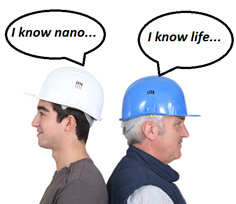
Robert Ferris, Ph.D.
Strategic Planner
With the burgeoning selection of nanotechnology-enabled products, we are simultaneously watching the creative destruction process at work. A company’s success or failure depend on a number of factors, including market dynamics, technology, and the leadership team. The most important of these, however, is the leadership team.
No product is launched in a vacuum; behind every successful launch is an interdisciplinary team of people working engineering, supply chain, and sales. The people are what progress the technology, work with customers, teach, learn, and execute for the company. The people that dare to leverage nanotechnology have to face both the common hurdles to new-technology commercialization and new challenges unique to nanotechnology.
Leadership teams formed around nanotechnology-enabled products must overcome the common challenges associated with new-product commercialization, including; production engineering, hurdles to customer adoption, and differentiation from competition.
Most leadership teams must manage through a variety of technology hurdles. For nanotechnology, these hurdles typically revolve around scale-up and quality control. The vast majority of nanotechnology-enabled products are just now exiting the bench-top or pilot scale. Each step towards production scale brings a new set of engineering challenges.
Large-scale production takes time and if economies of scale are not realized, or large scale production is not possible, the management team will be forced to pack-up shop. The decision to quit is never easy; usually a lot of time, effort, and money have been invested. As such, the decision is often delayed until facts outweigh emotions. A perfect example of how a technological failure can lead to a breakdown in leadership is with Solyndra. When the price of solar cells started to drop below Solyndra’s production cost, a massive leadership meltdown accelerated the collapse of the company.
If the technology is commercially viable, driving customer adoption requires clear communication and value proposition alignment. Take the recent innovations around nanoparticle additions to automobile tires. Major manufacturers, like Bridgestone or Goodyear, are using sub-50nm diameter nanoparticles as an additive. Introducing nanoparticles has decreased rolling resistance while improving traction. These benefits also reduce the carbon footprint of the tire. When a single innovation delivers so many advantages; the marketing team needs to decide which message will succeed in driving customer adoption and/or price premium. While some may argue the increased performance and lifetime, we see a lot of advertisements around the environmental benefits of the Bridgestone Ecopia tire brand. Only time will tell which message aligns with customer; but the responsibility sits with the leadership team, either way.
The final common barrier to market adoption is differentiation from competition. Differentiation is the largest opportunity for management team failure. All too often nanotechnology innovations appear as incremental improvements over current solutions.
Take batteries for example; in 2013 the rechargeable battery market was roughly $54 Billion with over 50% of battery sales coming from consumer applications (retail batteries). Over the past 20 years we have seen nearly a 2x improvement in volumetric energy density (Figure 1). Recent developments in nanotechnology have made batteries smaller, lighter, hold charge longer, and charge faster. But when you buy a consumer battery, do you think of all these innovations? No, we buy the size and brand we know (AAA or AA, Duracell or Energizer). The point is that customers’ decide to buy based on a number of variables and the management team must both understand and navigate these buying decisions to influence consumer behavior; not an easy task.

Figure 1. Volumetric Energy Density of Batteries since 1985. Source: https://electronicdesign.com/power/here-comes-electric-propulsion
Successful management of a nanotechnology-enabled product launch requires overcoming some additional unique challenges, including; lack of skilled workforce, generational differences, lack of common industry best-practices, and an uncertain regulatory environment.
The first hurdle for a leadership team is organizing the right team. With nanotechnology being a recent innovation, it is difficult to collect the right mix of expertise. Technologically speaking, overcoming nanotechnology-based engineering challenges requires a unique set of skills and experiences. Even graduate degree programs struggle with how to teach applied nanotechnology. On average, the experienced nanotechnology workforce is still coming from masters and doctoral degree programs.
As a result, few, if any, of these graduates have worked in a large-scale manufacturing environment. Because of the few number of graduate experienced in nanotechnology, and fewer available in the marketplace, there is a large gap in skilled workforce to assist in nanotechnology-enabled engineering and scale-up. Also there is a massive difference in experiences. A recent Ph.D. graduate may be perfectly equipped to navigate the scientific challenges of scale-up but has little context for what is feasible in the real world. In the like, a 20 year veteran engineer provides real experience in project engineering and management, but lacks the fundamentals around how the process or product should operate. A good leadership team will recognize each other’s experience strengths and constructively cooperate; a bad leadership team will only lead to failure.
The second hurdle is managing a combined interdisciplinary and cross-generational team. Many nanotechnology-based experts are from the Generation Y and Millennials’ generation while many experienced industrial engineers are from the baby-boom generation. That leaves a gap of anywhere from 20 to 45 years. Consider how technology, society, and communications styles have changed over those years. With such a major gap it is almost like managing a cross-cultural team; even if they were all raised within the same town. To be successful, the management team will have to navigate misunderstandings, conflicting styles, and differing opinions in the face of ambiguity. Combining the interpersonal dynamic of a nanotechnology team with the need to deliver an innovation on a deadline will challenge even the most weathered leadership.

Figure 2: Engineering teams must overcome both experience and generational differences to be successful.
Industry best practices have been accumulated for decades. For each industry, there are well-established practices that deliver lower production cost, economies of scale, and improved productivity. Everything from production vessel sizes to employee safety standards are documented and benchmarked. Unfortunately, nanotechnology has no equivalent to these benchmarks or best practices. Furthermore, rarely can a team confidently implement standards from another industry because of the range of unknowns. As a result, the leadership team usually has to earn through iteration to find a viable solution.
Those people working on large-scale production of graphene is currently undergoing this learning process. Graphene is considered one of the most promising new materials of the 21st century. Prestine graphene is commonly made through a Chemical Vapor Deposition (CVD) process on pure copper. Because the grain-size and surface roughness were critical for the CVD deposition, the copper was typically supported by a silicon wafer. As such, graphene production was limited to a single atomically thick layer on a 4 inch silicon wafer. Meaning one 4-inch wafer makes only 0.08 g of graphene and that it will take over 11 million wafers to produce one ton of graphene that is sold for roughly $200,000. In contrast, over 7.1 million tons of fiberglass will be produced globally in 2015 at a cost of roughly $6,000/ton.
Obviously using a silicon wafer with high-purity copper to product graphene makes industrial-scale production nearly impossible. So, the market place is working towards methods for large-scale graphene production. Because most nanotechnology-enabled products also lack a clear path to scale-up, the management teams have to undergo a similar learning curve. The learning process, however, increases both the time to market and cost to first production. This is a large reason why nanotechnology companies do not receive a lot of venture capital money; the investment timeline is too long and requires too much capital.

Figure 3: The leadership team of a nanotechnology-enabled product has to overcome a lot of ambiguity to become successful.
Finally, there is the massive uncertainty around regulation and litigation risk. The innovation management team has to navigate the unknowns around nanotechnology regulation, human exposure risk, and potential future litigation. One answer to this is to assume that all nanomaterial is toxic, however, the costs of manufacturing may be increased unnecessarily.
The other extreme is to assume that the nanomaterial is safe until proven otherwise. Doing so, however, risks future litigation fees similar to asbestos, which is currently topping $54 billion. Safe handling standards are trickling into the marketplace, but a lot is still unknown. The right balance is somewhere between these two extremes, but navigating this uncertainty again falls onto the responsibility of the management team.
In spite of these hurdles, technology innovation continues. Successful teams are formed every day and some even reach successful launch. Overtime the people, market, and technology will grow, learn, and consolidate. Eventually, the list of hurdles will be reduced to mere speed-bumps. Until then, however, best of luck to those pioneering teams that take on the challenge of commercializing nanotechnology. With great challenge comes the potential for great gains; or so we hope…
Stay tuned: My next post will review nanotechnology initiatives lead by current Emerson customers across various industries.
Robert Ferris, Ph.D. is a strategic planner with Emerson Process Managements. He holds a bachelors and masters in chemical engineering, an MBA in new technology commercialization, and a Ph.D. in Mechanical Engineering and Materials Science. He has an extensive background in nanotechnology development and advanced process control.
Please, share your opinion or questions! Reply below to provide your thoughts, insights, or comments with the experts.




